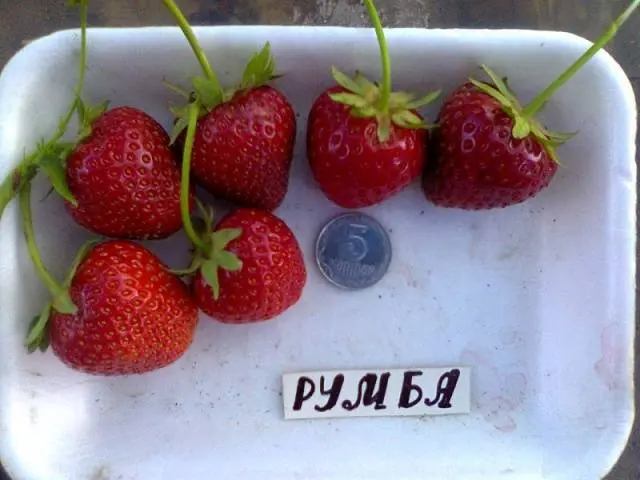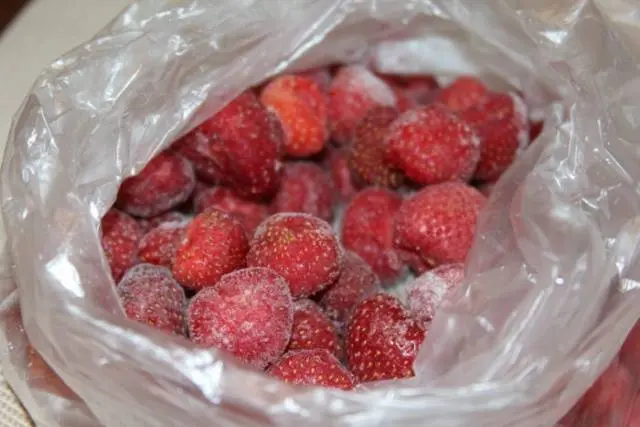Contents
The Dutch selection demonstrates steady progress in the formation of new proposals on the market of berry crops. The Rumba strawberry variety is a good example of this.

Short description
The Rumba strawberry variety belongs to the type of single fruiting garden strawberry. It is positioned as a worthy alternative to the Honey variety when cultivated in the northern zones. In recent years, Rumba strawberries have been confidently competing with him for positions in the industrial cultivation of this agricultural crop.
The table provides a description of Rumba strawberries:
| Fruiting | Start | Duration | Rumba yield |
| Falls on the first or second decade of June (depending on the area of cultivation). | About 3 weeks. | 200-250 grams per bush for the first year. Subsequent seasons 450-1000 grams. Depends on the age of the plant, the applied agricultural technology, natural and climatic conditions. | |
| Plant | A type | sheet apparatus | root part |
| Mixed. Rumba responds well to agricultural technology, the result of which can be a generative or vegetative direction. | Widely branched, large. The leaves have a rich dark green color and jagged edges. | Profuse fibrous root structure. Allows to transfer moderate frosts at a small snow cover. | |
| Berry | Shape and color | Size and weight | Aromatic and taste indicators |
| Uniform shape, with a minimum percentage of rejection to the total mass. Rumba forms the first fruits of the correct conical shape, all subsequent ones are round-conical. The color of the ripened berry is dark red, saturated, up to cherry. With a durable glossy finish. | A large percentage of the total crop is occupied by a large berry, a smaller one by a medium one. When weighing one Rumba berry, the dial shows 25-30 grams. | Sweet taste with a slight sourness, long strawberry aftertaste. The seeds are small and not felt when eating. Strawberry Rumba has a persistent pleasant smell. |
The described external data of the Rumba variety demonstrates a photo, the taste and aroma of strawberry lovers are evaluated only on their site.

The description includes the following advantages of strawberries, found in practice at Rumba by both gardeners and large farmers:
- The fruits are resistant to crushing during the growing season.
- Berries have a dense structure.
- Harvest is formed by a “bouquet” type.
- The berries are uniform in shape and weight.
- Large sheet machine.
- The variety has a powerful branched root system.
Negative characteristics:
- The level of sugar content of the variety noticeably reacts to external factors.
- Average values of Rumba strawberry tolerance to the main pathogens.
Cultivation in large farms
Seedlings are used on large areas. Professional farmers use the genetic predisposition of the Rumba variety to uniform fruit formation to obtain high-quality products.
The round shape reduces the area of contact between the berries. This has a positive effect on the appearance. The dense structure of the fruits of the variety makes it possible to transport strawberries for 2-3 days without compromising commercial qualities.
A dense texture, which means a heavy berry, is an important indicator that Rumba strawberries have. Due to this, the farmer generates additional profit when he sells the same amount of production for more money. And the “accuracy” of fruiting reduces labor costs and loss of time for harvesting.

Agricultural practices used
Rumba strawberry bushes are not compact. Therefore, experts plant seedlings at the rate of 4 bushes per 1 m2. Violation of this recommendation leads to thickening, lack of sunlight, poor air circulation. The result is deplorable: strawberries are deficient in nutrition due to internal cross-competition, stagnant locations form in the root zone, and a pathogenic environment accumulates.
The soil for Rumba is selected neutral or slightly acidic. Strawberries do not respond well to alkalization. If necessary, calcium sulphate, ammonium sulfate, rotted organics are added. When examining the soil in terms of mechanical parameters, a stake is placed on light soils, chernozem. Avoid planting varieties in heavy loamy areas.
Farmers use various types of dressings for Rumba-type strawberries – root, leaf. Especially during the fruiting period. The Rumba strawberry cultivar responds strongly to nutrient availability. At the slightest deficiency, the berry loses its taste, the plant becomes susceptible to diseases.
The Rumba variety reacts to the increased content of boron in the soil. The first signs are found on old strawberry leaves – brown spots cover their surface, the leaves die off. This factor is taken into account by agronomists when drawing up a plan for mineral supplements.
Farmers determine the cause by excluding diseases that have similar manifestations.
In order to get early products and manage to sell them at the highest possible price, farmers use greenhouse complexes and covering materials. Due to this, the fruiting period of the Rumba comes 2 weeks earlier.
Cultivation in the backyard
PSF owners and gardeners also allocate plots for this variety, or replace old strawberry plants with Rumba. The desired end result is somewhat different than that of industrialists. But the main parameters that they achieve remain the same – a high-quality fruit with excellent taste.
Based on the reviews, the Rumba strawberry variety has all the makings required for this. The main thing is to help the plant to show them.

Recommendations for those who plant this berry for the first time
Description of the Rumba planting method for a novice gardener:
- First, a site is determined where plants with pests and pathogens common to strawberries were not grown.
- Choose a place that is sufficiently lit, protected from gusts of wind.
- Pick up flat areas, without depressions and slopes.
- Rumba seedlings are planned to be planted both in autumn and in spring.
- In the first year, the mustache and part of the inflorescences are cut off from the variety for better survival.
- The surrounding area is cleared of weeds.
- To keep the berry clean, the ground around the strawberries is covered with chopped grass, straw. Mulch also keeps the soil from drying out.
- The perimeter of the cultivated area is planted with onions or garlic – the essential oils they release into the air confuse strawberry pests.
Although this strawberry variety tolerates relatively stable continental climate conditions, reviews of gardeners growing Rumba in wet and cool spring conditions indicate that the plant loses its taste when there is a lack of heat. This should be taken into account by residents of the northern zones.
The video gives a visual representation of the Rumba strawberry variety:
Application of fertilizers
Variety Rumba responds well to top dressing. This positive quality plays a bad joke when the gardener introduces excess nitrogen rates. Increased doses of the microelement provoke thickening of the stems and leaves of Rumba strawberries, to the detriment of the formation of fruits.
Preference is given to organics. Its action is extended in time. It improves soil structure. To do this, they take last year’s manure and cover the ground around each strawberry bush in the spring, before the start of laying inflorescences.
Fresh manure cannot be used – it is a source of pathogenic microorganisms. And also it contains nitrogenous compounds in such a concentration that leads to burns of the root system.
It is permissible to use mineral fertilizers to adjust the content of nitrogen, phosphorus and potassium in the soil.
Use of berries
The right approach to the cultivation of strawberries guarantees a bountiful harvest. Large farms use Rumba’s good transportability to supply strawberries to wholesale markets and canneries.
Small households consume the berries raw, as well as in various types of cooking.
Freezing
Strawberries are harvested in the morning, but only after the dew has subsided. Only the one that lay on the mulch layer or on the covering material is selected. The density of Rumba berries allows them to be stacked in layers immediately in the freezer. But the best effect is achieved in the following way:
- The berry is collected together with the stalk, which is separated immediately before storage.
- Wash lightly and lay out on paper towels to dry strawberries quickly.
- Rumba is laid in one layer on a pallet or a wide flat plate, after which it is placed in the freezer.
- After 6 hours, the strawberries are taken back, poured into a cling film bag.
- Laid back before winter.
Thanks to the recommendations, separate berries are obtained, which are convenient to take in the required quantity directly from the refrigerator, without taking out the entire package.

Making dessert
Rumba pleases not only with taste and aroma, but also looks spectacular in the form of jelly with whole strawberries.
Taken:
- A spoonful of gelatin.
- 350 ml hot water.
- 125 ml of cooled boiled water.
- 150 gram of sugar.
- 500 grams of strawberries.
The fruits of Rumba are separated from the stalk, most of them are ground on a blender, the smaller part is laid out in containers. Strawberry mass is transferred to a saucepan, mixed with water, brought to a boil and cooled.
Soften gelatin in cold water. Add to the pan to the boiled mass, heat until (not bringing to 100 ° C) until the gelatin is completely dissolved. Pour into molds with strawberries, cool, put in the refrigerator. Dessert is served chilled.
Reviews
Conclusion
Rumba, like any other strawberry variety, has its pros and cons. Taking into account the strengths and weaknesses will help in practice to reveal the full potential that this culture has.









